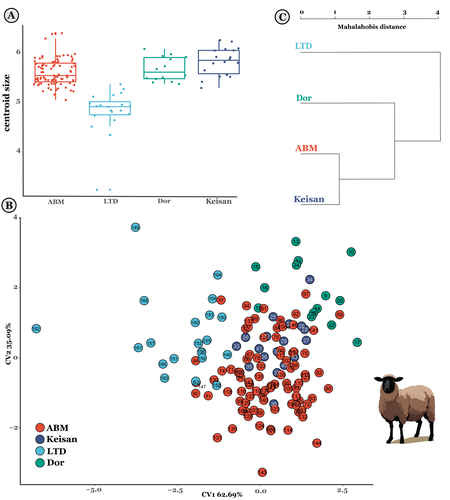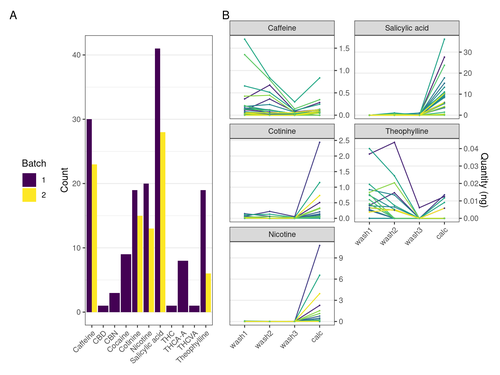
LE MEILLOUR Louise
- University of Copenhagen, Globe Institute, Copenhagen, Denmark
- Africa, Archaeometry, Bioarchaeology, Dating, Environmental archaeology, Neolithic, Paleoenvironment, Zooarchaeology
- recommender
Recommendations: 2
Reviews: 0
Recommendations: 2

The contribution of Mediterranean connectivity to morphological variability in Iron Age sheep of the Eastern Mediterranean
Exploring eastern Mediterranean Iron Age coastal connections through sheep astragali using geometric morphometrics
Recommended by Louise Le Meillour based on reviews by 4 anonymous reviewersIt currently seems obvious that the Mediterranean basin is a place of great exchanges of cultures, populations and goods. Although studies have focused quite extensively on the archaeology of maritime exchanges [1–3], it is challenging to assess archaeologically to what extent these networks had an influence on the biology of domesticated animals in the past, or even if animals were part of the trip. The question of past populations establishing extensive connections in the Mediterranean basin during the Iron Age and Persian period and especially, if these population exchange livestock and how these connections contributed to the animals phenotype or morphotype diversity is still difficult to document in the (zoo)archaeological record. These are amongst the questions Harding et al. [4] are making an attempt at documenting. Focusing on archaeological deposits from Cyprus and Israel in the eastern part of the Mediterranean basin, they use sheep astragali as a proxy to explore the potential connections that might have existed between evolution of the animals’ morphology and exchanges through sea travel. Postulating that animals from inland sites should have variant morphology from those of coastal sites due to more intensive exchanges for the latter, mainly because of the incorporation of non-native animals, they conducted geometric morphometrics analyses to make an attempt at documenting the phenomenon. Observing changes in size and shape, but also an increased morphological variability within the assemblages from coastal sites, they nicely discuss and put their results in perspectives with the archaeological record and literature [5,6]. Although, as they acknowledge, their sample size is rather limited to draw any general conclusion, this paper sheds new lights on the influence of maritime transport and its influence over domesticated sheep diversity between Cyprus and the southern Levant, paving the way for future studies.
References
1. Leidwanger, J. and Knappett, C. (2018). Maritime Networks in the Ancient Mediterranean World. (Cambridge University Press). https://doi.org/10.1017/9781108555685
2. Leidwanger, J. (2020). Roman Seas: A Maritime Archaeology of Eastern Mediterranean Economies. (Oxford University Press). https://doi.org/10.1093/oso/9780190083656.001.0001
3. Bernard Knapp, A., Russell, A. and van Dommelen, P. (2022). Cyprus, Sardinia and Sicily: A Maritime Perspective on Interaction, Connectivity and Imagination in Mediterranean Prehistory. Cambridge Archaeological Journal 32, 79–97. https://doi.org/10.1017/S0959774321000330
4. Harding, S. A., Hadjikoumis, A., Vermeersch, S., Shafir, R. and Marom, N. (2024) The contribution of Mediterranean connectivity to morphological variability in Iron Age sheep of the Eastern Mediterranean. bioRxiv2022.12.24.521859 https://doi.org/10.1101/2022.12.24.521859.
5. Price, M. D., Perry-Gal, L. and Reshef, H. (2023). The Southern Levantine pig from domestication to Romanization: A biometrical approach. J. Archaeol. Sci. 157, 105828. https://doi.org/10.1016/j.jas.2023.105828
6. Vigne, J., Zazzo, A., Cucchi, T., Briois, F. and Guilaine, J. (2014). The transportation of mammals to Cyprus shed light on early voyaging and boats in the mediterranean sea. Eurasian Prehistory 10, 157–176.

Multiproxy analysis exploring patterns of diet and disease in dental calculus and skeletal remains from a 19th century Dutch population
Detection of plant-derived compounds in XIXth c. Dutch dental calculus
Recommended by Louise Le Meillour based on reviews by Mario Zimmerman and 2 anonymous reviewersThe advent of biomolecular methods has certainly increased our overall comprehension of archaeological societies. One of the materials of choice to perform ancient DNA or proteomics analyses is dental calculus[1,2], a mineralised biofilm formed during the life of one individual. Research conducted in the past few decades has demonstrated the potential of dental calculus to retrieve information about past societies health[3–6], diet[7–11], and more recently, as a putative proxy for isotopic analyses[12].
Based on a proof-of-concept previously published by their team[13], Bartholdy and collaborators’ paper presents the identification of compounds and their secondary metabolites derived from consumed plants in individuals from a XIXth century rural Dutch archaeological deposit[14]. Sørensen indeed demonstrated that drug intake is recorded in dental calculus, which are mineralised biofilms that can encapsulate drug compounds long after the latter are no longer detectable in blood. The liquid-chromatography coupled to mass spectrometry (LC-MS/MS)-based method developed showed the potential for archaeological applications[13].
Bartholdy et al. utilised the developed LC-MS/MS method to 41 buried individuals, most of them bearing pipe notches on their teeth, from the cemetery of the 19th rural settlement of Middenbeemster, the Netherlands. Along with dental calculus sampling and analysis, they undertook the skeletal and dental examination of all of the specimens in order to assess sex, age-at-death, and pathology on the two tissues. The results obtained on the dental calculus of the sampled individuals show probable consumption of tea, coffee and tobacco indicated by the detection of the various plant compounds and associated metabolites (caffeine, nicotine and salicylic acid, amongst others).
The authors were able to place their results in perspective and propose several interpretations concerning the ingestion of plant-derived products, their survival in dental calculus and the importance of their findings for our overall comprehension of health and habits of the XIXth c. Dutch population. The paper is well-written and accessible to a non-specialist audience, maximising the impact of their study. I personally really enjoyed handling this manuscript that is not only a good piece of scientific literature but also a pleasant read, the reason why I warmly recommend this paper to be accessible through PCI Archaeology.
References
1. Fagernäs, Z. and Warinner, C. (2023) Dental Calculus. in Handbook of Archaeological Sciences 575–590. https://doi.org/10.1002/9781119592112.ch28
2. Wright, S. L., Dobney, K. & Weyrich, L. S. (2021) Advancing and refining archaeological dental calculus research using multiomic frameworks. STAR: Science & Technology of Archaeological Research 7, 13–30. https://doi.org/10.1080/20548923.2021.1882122
3. Fotakis, A. K. et al. (2020) Multi-omic detection of Mycobacterium leprae in archaeological human dental calculus. Philos. Trans. R. Soc. Lond. B Biol. Sci. 375, 20190584. https://doi.org/10.1098/rstb.2019.0584
4. Warinner, C. et al. (2014) Pathogens and host immunity in the ancient human oral cavity. Nat. Genet. 46, 336–344. https://doi.org/10.1038/ng.2906
5. Weyrich, L. S. et al. (2017) Neanderthal behaviour, diet, and disease inferred from ancient DNA in dental calculus. Nature 544, 357–361. https://doi.org/10.1038/nature21674
6. Jersie-Christensen, R. R. et al. (2018) Quantitative metaproteomics of medieval dental calculus reveals individual oral health status. Nat. Commun. 9, 4744. https://doi.org/10.1038/s41467-018-07148-3
7. Hendy, J. et al. (2018) Proteomic evidence of dietary sources in ancient dental calculus. Proc. Biol. Sci. 285. https://doi.org/10.1098/rspb.2018.0977
8. Wilkin, S. et al. (2020) Dairy pastoralism sustained eastern Eurasian steppe populations for 5,000 years. Nat Ecol Evol 4, 346–355. https://doi.org/10.1038/s41559-020-1120-y
9. Bleasdale, M. et al. (2021) Ancient proteins provide evidence of dairy consumption in eastern Africa. Nat. Commun. 12, 632. https://doi.org/10.1038/s41467-020-20682-3
10. Warinner, C. et al. (2014) Direct evidence of milk consumption from ancient human dental calculus. Sci. Rep. 4, 7104. https://doi.org/10.1038/srep07104
11. Buckley, S., Usai, D., Jakob, T., Radini, A. and Hardy, K. (2014) Dental Calculus Reveals Unique Insights into Food Items, Cooking and Plant Processing in Prehistoric Central Sudan. PLoS One 9, e100808. https://doi.org/10.1371/journal.pone.0100808
12. Salazar-García, D. C., Warinner, C., Eerkens, J. W. and Henry, A. G. (2023) The Potential of Dental Calculus as a Novel Source of Biological Isotopic Data. in Exploring Human Behavior Through Isotope Analysis: Applications in Archaeological Research (eds. Beasley, M. M. & Somerville, A. D.) 125–152. https://doi.org/10.1007/978-3-031-32268-6_6
13. Sørensen, L. K., Hasselstrøm, J. B., Larsen, L. S. and Bindslev, D. A. (2021) Entrapment of drugs in dental calculus - Detection validation based on test results from post-mortem investigations. Forensic Sci. Int. 319, 110647. https://doi.org/10.1016/j.forsciint.2020.110647
14. Bartholdy, Bjørn Peare, Hasselstrøm, Jørgen B., Sørensen, Lambert K., Casna, Maia, Hoogland, Menno, Historisch Genootschap Beemster and Henry, Amanda G. (2023) Multiproxy analysis exploring patterns of diet and disease in dental calculus and skeletal remains from a 19th century Dutch population, Zenodo, 7649150, ver. 5 peer-reviewed and recommended by Peer Community in Archaeology. https://doi.org/10.5281/zenodo.7649150